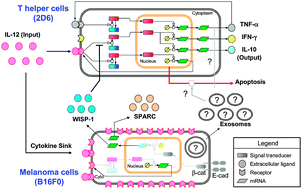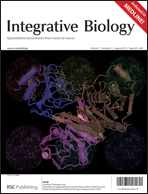A quantitative systems approach to identify paracrine mechanisms that locally suppress immune response to Interleukin-12 in the B16 melanoma model†
Abstract
Interleukin-12 (IL12) enhances anti-tumor immunity when delivered to the tumor microenvironment. However, local immunoregulatory elements dampen the efficacy of IL12. The identity of these local mechanisms used by tumors to suppress immunosurveillance represents a key knowledge gap for improving tumor immunotherapy. From a systems perspective, local suppression of anti-tumor immunity is a closed-loop system – where system response is determined by an unknown combination of external inputs and local cellular cross-talk. Here, we recreated this closed-loop system in vitro and combined quantitative high content assays, in silico model-based inference, and a proteomic workflow to identify the biochemical cues responsible for immunosuppression. Following an induction period, the B16 melanoma cell model, a transplantable model for spontaneous malignant melanoma, inhibited the response of a T helper cell model to IL12. This paracrine effect was not explained by induction of apoptosis or creation of a cytokine sink, despite both mechanisms present within the co-culture assay. Tumor-derived Wnt-inducible signaling protein-1 (WISP-1) was identified to exert paracrine action on immune cells by inhibiting their response to IL12. Moreover, WISP-1 was expressed in vivo following intradermal challenge with B16F10 cells and was inferred to be expressed at the tumor periphery. Collectively, the data suggest that (1) biochemical cues associated with epithelial-to-mesenchymal transition can shape anti-tumor immunity through paracrine action and (2) remnants of the immunoselective pressure associated with evolution in cancer include both sculpting of tumor


 Please wait while we load your content...
Please wait while we load your content...